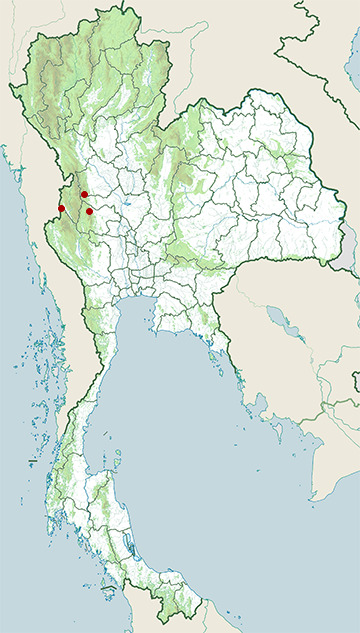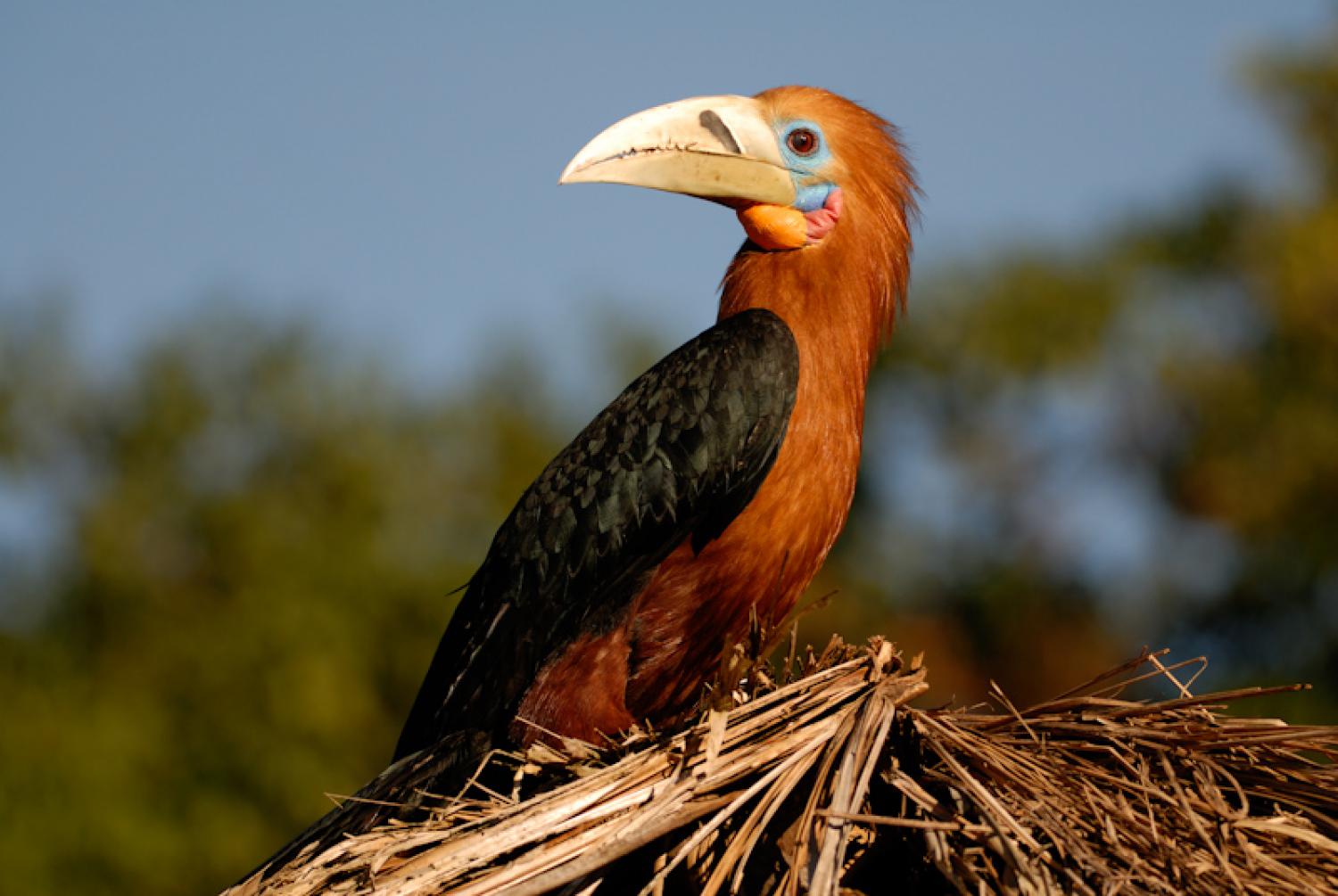Species of Thailand
Rufous-necked hornbill
Aceros nipalensis
Brian Houghton Hodgson, 1829
In Thai: นกเงือกคอแดง
The rufous-necked hornbill (Aceros nipalensis) is a species of hornbill in northeastern India, especially in Arunachal Pradesh, Indian Subcontinent and Southeast Asia. It is locally extinct in Nepal due to hunting and significant loss of habitat. There are < 10, 000 adults left in the wild. With a length of about 117 cm, it is among the largest Bucerotine hornbills. The underparts, neck and head are rich rufous in the male, but black in the female.
Description
The head, neck, and lower body of the male are coloured rufous, with deeper colouration on the flanks and abdomen. The middle primaries and the lower half of the tail are tipped white. The rest of the hornbill's plumage is a glossy dark-green and black. The lower tail-covert feathers are coloured chestnut mixed with black.
The female, on the other hand, is black, except for the end-portion of her tail and the tips of the middle primaries, which are white. Juvenile hornbills resemble adults of the same sex, but lack the ridges at the base of
the upper beak.
The beak lacks a true caique but is thickened at its base. It has a number of dark ridges on the upper beak which are absent in the young and increase in number with age up to about seven. The commissure of the beaks is broken for both sexes.
Distribution
Of all hornbills, this species has the northern-most extent, ranging from north-eastern India to western Thailand and north-western Vietnam.
In India, the hornbill has been recorded from the following protected areas:
- Namdapha National Park, Arunachal Pradesh.
- Manas National Park, Assam.
- Buxa Tiger Reserve, West Bengal.
- Mahananda Wildlife Sanctuary, West Bengal.
- Eaglenest Wildlife Sanctuary, Arunachal Pradesh.
- Kamlang Wildlife Sanctuary, Arunachal Pradesh.
- Sessa Orchid Sanctuary, Arunachal Pradesh.
- Pakke Tiger Reserve, Arunachal Pradesh.
The western limit of the rufous-necked hornbill is the Mahananda Wildlife Sanctuary in West Bengal.
Kinnaird and O'Brien (2007) have tabulated data for the hornbills of the world and report that rufous-necked hornbills range over 1, 163, 811 km2 of area, of which 825, 837 km2 of area are forested. Within this area, rufous-necked hornbills occur in 90 protected areas comprising 54, 955 km2 of protected forest but only including 7% of optimal hornbill habitat.
Ecology
While predominantly a bird of ridged and hilly forests, chiefly broadleaved forests at altitudes of 150 – 2200 m, it has also been recorded in dry woodland. The nesting period is from March to June, the trees preferred are tall and have broad girths. These hornbill communities move between one forest to another depending on seasonally to forage from fruiting trees that change with local conditions.
Describing the egg, Hume (1889) states:
:The egg is a broad oval, compressed somewhat towards one end, so as to be slightly pyriform. The shell is strong and thick, but coarse and entirely glossless, everywhere pitted with minute pores. In colour it is a very dirty white, with a pale dirty yellowish tinge, and everywhere obscurely stippled, when closely examined, with minute purer white specks, owing to the dirt not having got down into the bottoms of the pores., It measures 2-25 by 1'75 (inches).
Culture
The rufous-necked hornbill occurs in Sanskrit literature under the epithet vārdhrīnasa, a term which at times also has been used to refer to other Bucerotidae.
In Arunachal Pradesh, rufous-necked hornbills have been hunted by tribals for their feathers and beak.
Conservation
Already listed in CITES Appendices I & II, the species is vulnerable but occurs in a number of protected areas in India, China, Thailand and Bhutan. Due to increased information coming in about range and extent, it has been suggested that the rufous-necked hornbill be downgraded from IUCN status "Vulnerable" to "Near Threatened".
Recent initiatives by the Wildlife Trust of India, Arunachal Pradesh Forest Department and other citizens to conserve hornbills, which also target the rufous-necked hornbill, are the Hornbill Nest Adoption Programme, and a programme for replacing the use of real beaks with fibre-made replicas.
This article uses material from Wikipedia released under the Creative Commons Attribution-Share-Alike Licence 3.0. Eventual photos shown in this page may or may not be from Wikipedia, please see the license details for photos in photo by-lines.
Category / Seasonal Status
Wiki listed status (concerning Thai population): Rare
BCST Category: Recorded in an apparently wild state within the last 50 years
BCST Seasonal status: Resident or presumed resident
Scientific classification
- Kingdom
- Animalia
- Phylum
- Chordata
- Class
- Aves
- Order
- Bucerotiformes
- Family
- Bucerotidae
- Genus
- Aceros
- Species
- Aceros nipalensis
Common names
- Thai: นกเงือกคอแดง
Photos
Please help us review the bird photos if wrong ones are used. We can be reached via our contact us page.
Range Map

- Huai Kha Khaeng Wildlife Sanctuary
- Mae Wong National Park
- Thung Yai Naresuan Wildlife Sanctuary



